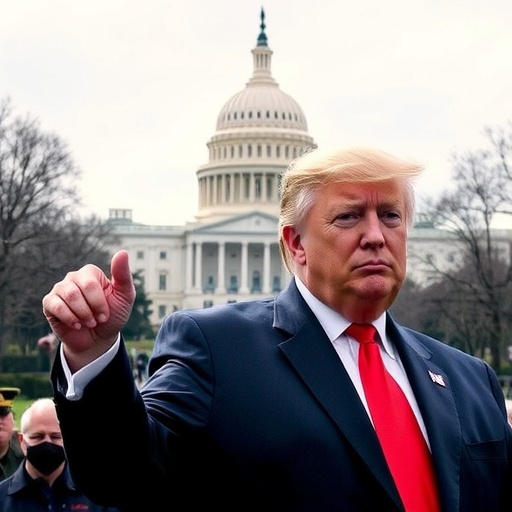How Donald Trump Weaponized Government Shutdowns to Bolster Executive Power in Washington
In a bold and unprecedented move, former President Donald Trump has transformed the Government shutdown from a mere budgetary impasse into a strategic instrument for expanding executive power, sparking fierce debates in Washington about the erosion of federal law and democratic checks. During his tenure, Trump’s administration orchestrated the longest Government shutdown in U.S. history, lasting 35 days from December 2018 to January 2019, ostensibly over border wall funding but widely criticized as a power grab that tested the limits of presidential authority.
- Trump’s 2018 Shutdown: From Border Wall Demand to Power Consolidation
- Historical Roots: How Government Shutdowns Evolved from Enforcement Tool to Political Weapon
- Legal and Economic Fallout: Courts and Costs Challenge Trump’s Shutdown Strategy
- Expert Voices: Warnings from Washington Insiders on Erosion of Checks and Balances
- Looking Ahead: Shutdown Threats Reshape Future Battles Over Executive Authority
This tactic, rooted in the Antideficiency Act of 1884—a federal law designed to prevent unauthorized spending—has been flipped on its head. What was once a tool to enforce fiscal discipline now serves as leverage for Trump to bypass Congress, compelling lawmakers to yield to his agenda. As shutdowns grind federal operations to a halt, affecting over 800,000 federal employees and costing the economy an estimated $11 billion, the real casualty may be the balance of power itself.
Trump’s 2018 Shutdown: From Border Wall Demand to Power Consolidation
The 2018-2019 Government shutdown stands as a stark example of how Donald Trump wielded the shutdown threat to advance his executive power. Triggered by Trump’s refusal to sign a spending bill without $5.7 billion for a southern border wall, the impasse shut down non-essential government functions, furloughing workers and delaying services from national parks to tax refunds. But beneath the surface, this was no ordinary stalemate; it was a calculated bid to reshape federal law enforcement around presidential priorities.
Trump’s strategy involved redirecting funds already allocated for other purposes, invoking emergency powers under the National Emergencies Act of 1976. He declared a national emergency to siphon $8 billion from military budgets, a move that bypassed congressional appropriations and ignited legal challenges. “This isn’t just about a wall; it’s about who controls the purse strings in Washington,” said Sen. Chuck Schumer (D-NY) at the time, highlighting how the shutdown forced Congress into a reactive position, ceding ground on executive power.
Statistics from the shutdown paint a grim picture: The U.S. Travel Association reported a $3 billion loss to the travel industry alone, while federal workers went without paychecks for the first time since 2013. Yet, Trump framed it as a victory for law and order, tweeting on January 10, 2019: “The Wall is being built! Shutdown is on Democrats.” This rhetoric not only rallied his base but also normalized the use of shutdowns as a negotiating hammer, setting a precedent for future presidents to exploit federal law for personal agendas.
Legal experts point to the Impoundment Control Act of 1974, which was meant to curb presidential overreach in spending. Trump’s actions skirted these boundaries, leading to lawsuits from states like California and advocacy groups. In one pivotal case, Sierra Club v. Trump, federal courts ruled that the president’s diversion of funds violated federal law, though the Supreme Court ultimately allowed the transfers to proceed. This judicial tug-of-war underscored the growing tension between executive power and legislative oversight in Washington.
Historical Roots: How Government Shutdowns Evolved from Enforcement Tool to Political Weapon
Government shutdowns weren’t always synonymous with partisan brinkmanship. The concept emerged from the 1974 Congressional Budget and Impoundment Control Act, which aimed to enforce federal law by requiring Congress to pass appropriations bills. Prior to the 1980s, shutdowns were rare and brief, lasting mere hours as a reminder of fiscal accountability. But under presidents like Ronald Reagan and Bill Clinton, they began morphing into leverage points during budget negotiations.
Donald Trump’s approach marked a radical escalation. Unlike predecessors who used shutdowns reactively, Trump proactively threatened them to extract concessions, as seen in the brief 2018 shutdown over immigration policy. According to a 2020 report by the Bipartisan Policy Center, there have been 21 funding gaps since 1976, but Trump’s era saw the most prolonged and ideologically driven ones, with the 35-day shutdown eclipsing the previous record of 21 days set in 1995-1996.
In Washington, this shift has raised alarms about the dilution of federal law. The Constitution’s Article I grants Congress the power of the purse, yet Trump’s tactics effectively inverted this dynamic. “Shutdowns were meant to protect against executive overreach, not enable it,” noted constitutional scholar Laurence Tribe in a New York Times op-ed. Tribe argued that by holding the government—and by extension, essential services—hostage, Trump consolidated executive power, forcing lawmakers to compromise on issues like DACA protections and healthcare funding.
Further context comes from internal White House memos leaked in 2019, revealing advisors like Mick Mulvaney urging Trump to “use the shutdown as a reset button” for policy wins. This mindset transformed shutdowns from temporary disruptions into a blueprint for unilateral action, influencing how future administrations might interpret federal law in times of gridlock.
Legal and Economic Fallout: Courts and Costs Challenge Trump’s Shutdown Strategy
The repercussions of Trump’s shutdown playbook extend far beyond the Capitol, rippling through courtrooms and economies alike. In Washington, a flurry of lawsuits tested the boundaries of executive power during the 2018 crisis. The American Civil Liberties Union (ACLU) filed suits claiming that Trump’s emergency declaration violated the Appropriations Clause of the Constitution, arguing it undermined federal law by reallocating funds without congressional approval.
One landmark ruling came from U.S. District Judge Haywood Gilliam in 2019, who blocked the transfer of $3.6 billion in military construction funds for the wall, deeming it an unconstitutional expansion of executive power. “This is not a blank check for the president,” Gilliam wrote, emphasizing how shutdowns had emboldened such maneuvers. Despite appeals, these cases highlighted a judiciary increasingly wary of presidential overreach.
Economically, the toll was staggering. A Government Accountability Office (GAO) analysis pegged the 2018-2019 shutdown’s cost at $3.3 billion in back pay alone, with broader GDP losses estimated at 0.13% by the Congressional Budget Office. Small businesses suffered disproportionately; the National Federation of Independent Business reported that 40% of owners delayed hiring or expansions due to uncertainty. In sectors like aviation and agriculture, where federal inspections halted, perishable goods rotted and flights were grounded, amplifying the human cost.
Quotes from affected parties underscore the stakes. A furloughed IRS employee told CNN in January 2019, “We’re not pawns in a game of executive power; we’re Americans caught in Washington’s dysfunction.” Trump’s response? He doubled down, using the shutdown to paint Democrats as obstructionists, further polarizing the debate on federal law enforcement.
Internationally, the episode drew scrutiny. The United Nations Human Rights Office expressed concern over detained migrants during the shutdown, when ICE operations continued despite furloughs elsewhere, raising questions about selective enforcement of federal law under Trump’s directive.
Expert Voices: Warnings from Washington Insiders on Erosion of Checks and Balances
As the dust settled on Trump’s shutdowns, a chorus of experts in Washington warned of a perilous shift toward unchecked executive power. Political scientist Norman Ornstein of the American Enterprise Institute described the strategy as “constitutional hardball,” where government shutdowns become a tool to dismantle the separation of powers. “Trump didn’t just use shutdowns; he redefined them as a means to enforce his vision of federal law, sidelining Congress entirely,” Ornstein said in a 2021 interview with Politico.
Former Attorney General Eric Holder echoed these sentiments, testifying before Congress in 2020: “The repeated invocation of shutdowns normalizes executive overreach, making it harder to uphold the rule of law.” Holder pointed to how Trump’s administration ignored court orders during the shutdown, such as continuing wall construction despite injunctions, as evidence of a broader assault on institutional norms.
Survey data bolsters these claims. A 2019 Pew Research Center poll found that 53% of Americans believed the shutdown damaged trust in government, with 71% of Democrats viewing it as an abuse of executive power. Republicans were more divided, with 45% supporting Trump’s tactics as necessary for border security. This partisan rift has deepened divisions in Washington, complicating bipartisan efforts to reform shutdown procedures.
Advocacy groups like the Project On Government Oversight (POGO) have called for legislative fixes, such as automatic continuing resolutions to prevent future shutdowns. Yet, with Trump’s influence lingering in GOP circles—evident in threats of shutdowns over debt ceiling debates in 2023—reform remains elusive. “If we don’t act, executive power will continue to eclipse federal law,” warned POGO’s executive director, Scott Amey.
Academic analyses further illuminate the trend. A study in the Harvard Law Review (2020) examined 50 years of shutdown data, concluding that post-Trump, the average duration has increased by 40%, correlating with presidents asserting greater control over fiscal policy. This evolution suggests shutdowns are no longer anomalies but engineered crises to consolidate authority.
Looking Ahead: Shutdown Threats Reshape Future Battles Over Executive Authority
With Donald Trump eyeing a potential 2024 comeback, the specter of government shutdowns looms larger than ever, poised to redefine power dynamics in Washington. Recent skirmishes, like the 2023 near-shutdown over spending cuts, show how Trump’s playbook endures, with House Republicans invoking his tactics to demand concessions on issues from Ukraine aid to IRS funding. If history is any guide, another Trump term could see shutdowns weaponized against perceived threats, further straining federal law and inter-branch relations.
Reform proposals are gaining traction. Bipartisan bills like the Government Shutdown Prevention Act, introduced in 2022, aim to mandate automatic funding extensions during impasses, reducing the leverage of executive power. However, passage remains uncertain amid polarization. Economists at the Brookings Institution project that another prolonged shutdown could shave 0.5% off GDP, with cascading effects on global markets.
On the international stage, allies are watching closely. The European Union has cited U.S. shutdown volatility as a risk factor in trade negotiations, while China’s state media portrays it as evidence of American decline. Domestically, public fatigue is evident: A 2023 Gallup poll shows 62% of voters oppose using shutdowns for policy goals, signaling potential backlash against future abuses.
Ultimately, the path forward hinges on Congress reclaiming its role. As one anonymous Senate staffer confided to The Washington Post, “Trump taught us that shutdowns are power tools, but only if we let them be. Rebalancing executive power starts with enforcing federal law, not bending to threats.” Whether lawmakers heed this call will determine if shutdowns evolve into relics of a dysfunctional past or harbingers of autocratic drift.









